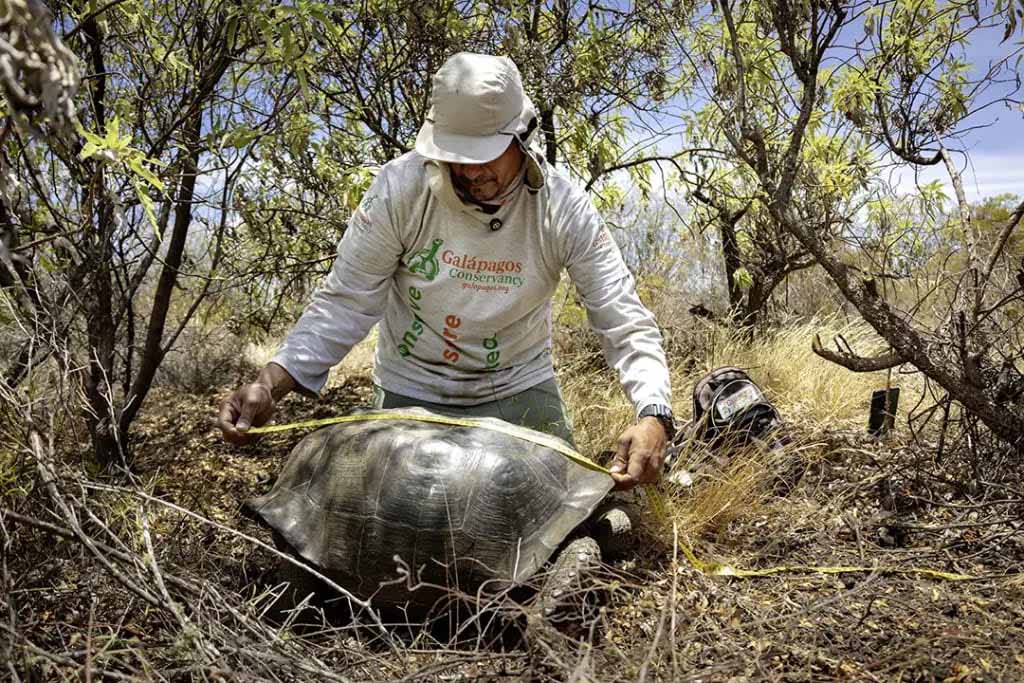In the crater on Isabela Island of Wolf Volcano, a tiny population of Giant Tortoises (Chelonoidis Becki) have survived in one the harshest environments of the Galapagos. These tortoises are isolated on a small flattened plateau of the wall of the crater that collapsed many years ago. The discovery of young tortoises, which face unique challenges for their long-term existence, in this remote region offers new hope that they can become a self-sustaining community.
A Remarkable Discovery
A small population of 50 tortoises has adapted to the harsh conditions of the volcano crater. The area is only 0.8 square miles (2.2 square kilometers), and the walls are over 200 meters high. They rely on seasonal rains and scarce vegetation to survive. The tortoises cannot climb the walls of the crater and communicate with each other.
This discovery is a positive sign of natural reproduction. This discovery not only demonstrates their resilience, but also highlights the importance of continuing conservation efforts.
Finding juveniles in an environment so harsh and isolated highlights their amazing resilience and ability thrive in extreme circumstances. This is an encouraging sign that these tortoises have been successfully reproducing, and maintaining their population,” said Dr. Jorge Carrion is the Director of Conservation for Galapagos Conservancy.
Technology Advancing Conservation
Galapagos Conservancy uses cutting-edge technology in order to better understand these tortoises and protect them. Researchers can collect critical data by equipping individuals with satellite tracking devices. This will help guide conservation strategies.
These trackers are vital tools for studying how tortoises adapt to their environment. “It’s a continuous effort, but it is essential for the survival” of this unique population,” Dr. Carrion says.
The Challenges of the Future
The crater is still a harsh habitat, despite this encouraging discovery. Food and water shortages–especially during prolonged dry periods–continue to pose a significant challenge. The presence of juveniles indicates that the population is likely to grow and persist.
Galapagos Conservancy is committed to the protection of these tortoises. We are committed to ensuring that future generations will be able to see these amazing creatures thrive in one of Earth’s most unique landscapes.

©Galápagos Conservancy
In order to promote environmental awareness and appreciation of the archipelago’s unique biodiversity, Galapagos Conservation in collaboration with educational institutions located on Floreanaand Isabela Islands recently organized a contest focusing on the protection of the iconic Galapagos Giant Tortoises.
Children and students participated in the contest with enthusiasm, displaying their creativity and imagination through vibrant and colorful artwork. Their drawings also conveyed messages of love and affection for Galapagos, its giant tortoises and the archipelago. The children’s art pieces not only showed their talent, but also their dedication to the conservation of these amazing creatures – an undeniable icon of the archipelago.
Celebrate the Winners
Four students received recognition for their originality and artistic quality. YazuProano, Luis Quijosaca, AlejandroMorocho, and Daniela Quituna, all from Floreana Island and Isabela Island respectively, were recognized for their outstanding drawings. They showed both an exceptional level of creativity and a profound understanding of giant tortoises, and the importance of protecting them.
The winning artworks showed that Galapagos giant tortoises were not only one of the most fascinating and iconic species, but also a well-known symbol of the archipelago. They are a major attraction to thousands of tourists each year. The students’ drawings emphasized the importance of protecting tortoises in maintaining biodiversity and the ecological integrity on the islands.
Collaboration with the Education System
This contest highlighted the importance of engaging young people and children in activities that strengthens their connection to nature and commitment to conservation of Galapagos. Jenny Macias is our educational advisor. She highlighted the positive impact the initiative has had on fostering environmental values and respect at a young age. She said that these educational activities encourage creativity and also help to build an emotional bond with the natural wonders of Galapagos.
Inspiring future generations
Galapagos Conservancy is proud to be the organizer of this initiative that combines art, conservation, and education. The students’ dedication is a testament to the importance of investing into initiatives that promote a love of Galapagos, and its unique species.
This contest is a powerful reminder of the importance of environmental education in forming future Galapagos guardians, who will be responsible to preserve these natural treasures.
A young student of the Jacinto Gordillo Educational Unit, Isabela, addresses the community to highlight the importance protecting giant tortoises.
The students shared their messages and showcased their work with the community.

©Galápagos Conservancy
Every year, on the 24th of January, the world celebrates International Day of Education. This day is dedicated to highlighting the importance of education as an essential human right and the power it has to create a sustainable future. Galapagos Conservation uses this occasion to reaffirm its commitment to education, especially in protecting and conserving the unique Galapagos Archipelago ecosystems.
We are proud of all the progress that we have made as we enter our ninth year of the Education for Sustainability Program. This program was launched in 2016 with the collaboration of Ecuador’s Ministry of Education. We have been providing teachers with the resources and training they need over the years to integrate sustainability issues into the lessons of children and young adults. Our goal was to instill a sense of responsibility for the environment, which is essential to ensuring long-term preservation of this fragile natural environment.
The New Focus for 2024
The year 2024 will be remembered as a landmark for our educational initiatives. Our commitment to quality education was reaffirmed by integrating sustainability at the heart of our work. Thanks to the collaboration of local and national experts, teachers in Galapagos received innovative, modern teaching materials. These professionals worked closely together with educators from across the archipelago to facilitate workshops, offer guidance and promote project-based learning tailored to local contexts.
Jenny Macias is our educational advisor and she emphasizes the importance of adapting local realities. “Our goal to empower teachers in integrating sustainability into their curriculums and adopting active teaching methods to meet the unique local needs.”
We also want to encourage children and youth to play a more active role in the building of sustainable communities. We bring teachers, students and families together to tackle local challenges using sustainable, context-driven, solutions by fostering learning communities in schools.
Education as a catalyst for conservation
On International Day of Education we celebrate not only the right of education but also its transformative powers in advancing sustainability and conservation. Galapagos Conservancy understands that sustainability education is essential to preserve our unique ecosystems, and foster a harmonious relationship between the local communities and the natural environment.
Our educational programs aim to inspire and motivate a new generation to protect and conserve the natural heritage of Galapagos, with a vision to extend this legacy beyond the Galapagos Islands. Education can be a powerful tool to encourage positive change and the integration of sustainability in all aspects of our lives.
Galapagos Conservancy will continue to place education at the forefront of its mission to ensure a sustainable and prosperous future for all generations.

Through the Galapagos Initiative in 2024, the Galapagos Conservancy along with the Galapagos National Park Directorate achieved important breakthroughs for the preservation of the Galapagos Islands’ unique ecosystems. Our efforts to protect iconic species and restore their natural habitats reflect our unwavering commitment towards a sustainable future. Here are some of the most significant achievements from the past year:
Pink Iguanas: Protecting them from harm
Four scientific expeditions on Wolf Volcano were conducted to close knowledge gaps regarding the Pink Iguana a critically endangered reptile native to Galapagos. Over two million images have been collected using a network of cameratraps to monitor the iguana populations. In order to better understand the ecological niche of pink iguanas, the team deployed environmental sensors. The data collected will help us better understand the biology of pink iguanas and provide the basis for the species Conservation Plan that will be implemented in the next year to ensure the survival of the species and restore its habitat.
Tracking Giant Tortoise Movements
We now have 90 tortoises being monitored remotely across different islands. This is thanks to the devices attached to two six turtles on San Cristobal Island. This technology gives us valuable information about their migration patterns, nesting sites, and habitat use. These insights are crucial to understand the natural history and habitat of the Galapagos giant tortoises, and to develop more effective strategies for protecting their habitats.
Ecological Monitoring of Santa Fe Island
The ongoing ecological monitoring by our team on Santa Fe Island was critical to assessing the impact of the giant tortoise project, and the effects it had on the island ecosystems. Since 2015, 600 tortoises from Espanola Island were brought to the island to replace the extinct species. Field surveys conducted in 2024 confirmed that the tortoises were thriving and dispersing throughout the island. They also played a greater role in restoring island ecosystem. The presence of tortoises promotes the growth of cactus and reduces the overgrowth by woody plants. The population of the endemic Santa Fe Island land iguana continues to increase, indicating a positive interaction between the tortoises and the endemic iguana. Both herbivores are contributing to the slow recovery in the island’s eco-system.
Yellow Land Iguanas – Two Tales of Resilience and Restoration across the Archipelago
- Recapture of Yellow Land Iguanas on Isabela Island. Our team captured many yellow land iguanas after they were released from captivity. This success shows the effectiveness of head-starting and captive breeding programs in restoring a threatened species.
- Translocation of North Seymour Island to Santiago Island: The iguanas on North Seymour Island were used as “nurseries” to transfer to Santiago Island where they had been extinct for more than a century. After a rigorous quarantine, over 500 iguanas from North Seymour were relocated to the north of Santiago Island, where they have thrived and are showing signs of breeding.
Albatross Frequent Flyers
In the absence of giant tortoises, woody plants had grown over 50 landing sites that were critical for the Waved Albatross to access their nesting site on Espanola Island. The clearing of these areas will ensure safe landings for the albatrosses who are returning to their nesting area following their incredible migratory trips across the eastern Pacific Ocean.
Protecting Galapagos Petrel Nesting Areas
Santa Cruz Island was cleared of invasive blackberry plants, guava trees, and quinine shrubs. The Galapagos Petrel is a rare and endemic bird that nests only on the sides of volcanoes within the archipelago. Our team has also resumed monitoring nesting colonies in Santiago and Isabela Islands. They found the first chicks of the petrel on Isabela Island for decades, and provided vital data that will help assess conservation status on both islands.
Strengthening Giant Tortoise Protection on Isabela
We will intensify our efforts in 2024 to protect the giant turtles of southern Isabela. These tortoises are under severe threat from invasive species like fire ants and cattle. In 15 expeditions, we collected 72 eggs and two hatchlings from remote nesting sites on the Sierra Negra volcano. The nests were then carefully moved to the Arnaldo Tupiza Breeding Center in Isabela. This initiative is the first in more than 12 years and marks an important step towards accelerating the recovery.
These achievements demonstrate the impact that Galapagos Conservancy has had on the world’s most remarkable ecosystems. Each achievement demonstrates our commitment to protecting Galapagos’ unique biodiversity, and ensuring that this natural legacy continues for future generations.

Hugo Mogollon is named new CEO and president of Galapagos Conservancy
Washington, DC, 2025: Galapagos Conservancy announces the appointment of Hugo Mogollon to its position as Chief executive officer and president. This will take effect on 24 February 2025. This appointment is historic as it marks the first time that an Ecuadorian has led the organization. It also reinforces Galapagos Conservancy’s commitment to local leadership, and its mission to preserve the Galapagos Islands.
Hugo Mogollon has over 20 years of experience working in the nonprofit sector, particularly in conservation and sustainability. His Ecuadorian heritage and extensive experience make him uniquely qualified to lead Galapagos Conservancy in a new phase of growth and impact. Hugo’s most recent position as Executive Director of FRESHFARM saw him significantly increase the budget and reach of the organization, making it a leader for food systems work in Washington Metropolitan Region.
Hugo has shown a strong commitment to scientific research and environmental conservation throughout his career. He spearheaded initiatives for the protection of endangered species and their habitats as Executive Director at Finding Species while advocating impactful conservation policies. He managed projects that fostered multisector partnerships between U.S. federal agencies and Ecuadorian governments.
Hugo has a Bachelor of Science degree from Universidad Catolica de Quito, and a Masters in Natural Resources Leadership for Sustainability at Virginia Tech. He also received executive leadership and organization management training from Stanford University and Northwestern University’s Kellogg School of Management. His work has received prestigious awards such as the EXCEL Award and the David Bradt Award for Nonprofit Leadership.
Hugo Mogollon said, “It is an honor to lead the Galapagos Conservancy in preserving one of nature’s greatest treasures.” My experience in science and conservation, as well as nonprofit leadership, has prepared me for an incredible opportunity. I am looking forward to working with the talented team of Galapagos Conservancy, and Conservando Galapagos in order to achieve our mission and secure a sustainable future for this Archipelago.
James Gibbs will take on the role of Vice-President of Science and Conservation. He was previously President of Galapagos Conservancy. James Gibbs will be focusing on Galapagos Conservancy’s research and conservation efforts in this role.
Dan Sherman, board chair of Galapagos Conservancy, said: “We are grateful for James Gibbs extraordinary leadership and contribution during his tenure as president.” Hugo Mogollon is our new CEO and president. We are delighted to welcome him. His appointment is a major milestone for the organization, and it reflects our commitment towards empowering local leaders and ensuring Galapagos Conservancy’s long-term sustainability.
This transition of leadership coincides with Galapagos Conservancy preparing to celebrate its 40th Anniversary in 2025. The organization is well-positioned for continued success and impact in the future, building on the legacy of protecting the Galapagos Islands’ unique biodiversity.
The small community of Floreana island in the southernmost Galapagos Islands celebrated a major milestone with a modest and heartfelt celebration: the opening of its Community Library. This new space does not only represent access to information, but also unity, progress and the hope of a better future for all residents on the island. The island is home to 50 families, with 30 students.
A Dream Realized Through Collective Effort
A library can make a huge difference in the daily lives of people living on an island like Floreana, where logistical issues limit their access to basic materials. This library is a new world of creativity and learning for the children and youth on the island who have only had limited access to educational materials. Adults can use it to foster community growth and strengthen bonds within the island.
The combined efforts of Galapagos Conservation and Silversea Cruises, an ultra-luxury cruise company operating in Galapagos who joined forces together to make this dream a reality. This initiative was created with a clear vision: to support local communities who are essential to the conservation of Galapagos’ unique biodiversity.
Book Space: More than Books
The Floreana Community Library offers more than just a place for reading. The Floreana Community Library is a multifunctional place where people can come together, learn and collaborate. The library hopes to inspire a younger generation through educational workshops, cultural events, and projects to enhance collective knowledge.
Children eagerly explored and examined the shelves, and the laughter and gratitude that filled the air during the inauguration was contagious. This space is quickly becoming a symbol of the commitment to education and community development.
The Future is Our Commitment
Galapagos Conservancy is committed to enhancing this initiative and ensuring that the library remains an important resource for the local community. The future plans include expanding the library’s book collection, introducing educational programs and organizing community-wide activities.
Floreana Community Library is a reminder that in a world rapidly changing, it’s important to invest in people. They have the potential to change their environment. This is only the beginning of an exciting story that will have lasting effects on the community and the well-being for those who live in this archipelago.
The Message of Hope
The library is much more than a building. It’s also a window into the world, and a reminder of the power education has to transform lives even in remote locations. Floreana Island has an incredible amount of biodiversity and a rich history. Now, it can benefit from a library that will strengthen its community and its people.
This library is a great example of how supporting local communities while conserving the Galapagos Islands can go hand-in-hand to create a more sustainable and brighter future.
